E231 series
| E231 series | |
|---|---|
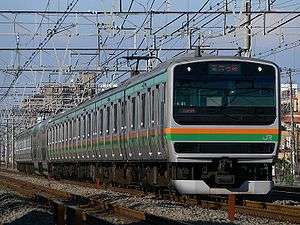 An E231-1000 series suburban type train in January 2006 | |
| Manufacturer | JR East, Kawasaki Heavy Industries, Tokyu Car Corporation |
| Built at | Niitsu, Kobe, Yokohama |
| Replaced | 103 series, 111 series, 113 series, 115 series, 201 series, 205 series, 301 series |
| Constructed | 1998–2006 |
| Entered service | March 2000 |
| Number built | 2,736 vehicles |
| Number in service |
2,594 vehicles (+20 vehicles converted to E235 series) |
| Number scrapped | 122 vehicles |
| Formation | 4/5/8/10/11 cars per trainset |
| Operator(s) | JR East |
| Depot(s) | Kawagoe, Keiyo, Kōzu, Matsudo, Mitaka, Oyama, Tokyo |
| Line(s) served | Chuo-Sobu Line, Hachiko Line, Ito Line, Joban Line, Joetsu Line, Kawagoe Line, Keiyo Line, Musashino Line, Narita Line, Ryōmō Line, Shonan-Shinjuku Line, Takasaki Line, Tokaido Main Line, Tokyo Metro Tozai Line, Utsunomiya Line, Yamanote Line, Yokosuka Line |
| Specifications | |
| Car body construction | Stainless steel |
| Car length | 20,000 mm (65 ft 7 in)[1] |
| Width | 2,950 mm (9 ft 8 in)[1] |
| Doors |
4/6 pairs per side 2 doors per side (Green cars) |
| Maximum speed | 120 km/h (75 mph)[1] |
| Traction system | IGBT-VVVF |
| Acceleration | 2.5 km/h/s, 3.0 km/h/s or 3.3 km/h/s |
| Deceleration | 4.0 km/h/s (4.5 km/h/s for emergency brake) |
| Train heating | AU725/AU726 |
| Electric system(s) | 1,500 V DC overhead |
| Current collection method | Overhead line |
| Bogies | DT61 (powered), TR246 (trailer) |
| Braking system(s) | Regenerative brake, electronically controlled pneumatic brakes |
| Safety system(s) | ATS-P, ATS-SN, D-ATC |
| Coupling system | Shibata-type |
| Multiple working | E233-3000 series (for E231-1000 series only) |
| Track gauge | 1,067 mm (3 ft 6 in) |
The E231 series (E231系 E231-kei) is an electric multiple unit (EMU) train type used for commuter and outer-suburban services operated by East Japan Railway Company (JR East) in Japan since 2000.
Design
Trains were manufactured by Tokyu Car Corporation, Kawasaki Heavy Industries and also at JR East's factory at Niitsu in Niigata Prefecture.
Variants
- / / E231-0 series: 8-car, 10-car, and 10+5-car sets used on the Chuo-Sobu Line, Joban Line, Narita Line, Musashino Line, and Keiyo Line
- / E231-500 series: 11-car sets used on the Yamanote Line, and 10-car sets used on Chuo-Sobu Line
- E231-800 series: 10-car sets used on Chuo-Sobu Line and Tokyo Metro Tozai Line interrunning services
- E231-900 series: Prototype 10-car set used on the Chuo-Sobu Line
- E231-1000 series: 10+5-car suburban sets used on the Tokaido Line, Utsunomiya Line, and Takasaki Line
- E231-3000 series: 4-car sets converted from former E231-0 series sets for use on the Kawagoe Line and Hachiko Line
The type evolved from the earlier 209 series and E217 series EMUs, with the main visible difference being wider bodies (2,950 mm compared to the 2,800 mm for earlier commuter trains), and the prototype train built in 1998 for trials on the Chuo-Sobu Line was actually classified 209-950 series, later becoming E231-900 series. Full-production E231-0 series trains were subsequently introduced on the Chuo-Sobu Line (10-car sets) and Joban Line (10+5-car sets). Other variants include the 11-car E231-500 series for the Yamanote Line, and the E231-800 series with 2,800 mm wide bodies and end doors for use on Tokyo Metro Tozai Line inter-running services.
From 2000 onward, the first E231-1000 series outer-suburban variant was delivered for use on Utsunomiya Line and Takasaki Line services north from Ueno Station in Tokyo. These trains included transverse seating in some cars and were also equipped with toilets. Production continued into 2006 with trains delivered for use on the Tokaido Main Line south from Tokyo. From 2004 onward, two bilevel Green cars were inserted into all E231-1000 series ten-car sets.
E231-0 series
| E231-0 series | |
|---|---|
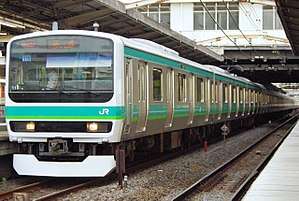 A Joban Line 10+5 car set in June 2017 | |
| Replaced | 103 series, 103-1000 series, 201 series, 205 series |
| Constructed | 2000–2006 |
| Entered service | 13 March 2000 |
| Number built | 725 vehicles |
| Number in service |
699 vehicles (80 sets) (+8 vehicles converted to E231-3000 series) |
| Number scrapped | 18 vehicles |
| Formation | 5/8/10 cars per trainset |
| Operator(s) | JR East |
| Depot(s) | Matsudo, Mitaka, Keiyo |
| Line(s) served | Chuo-Sobu Line, Joban Line, Keiyo Line, Musashino Line, Narita Line |
| Specifications | |
| Car body construction | Stainless steel |
| Width | 2,950 mm (9 ft 8 in) |
| Doors | 4/6 pairs per side |
| Electric system(s) | 1,500 V DC overhead catenary |
| Current collection method | PS33B pantograph |
| Track gauge | 1,067 mm (3 ft 6 in) |
Originally, 46 ten-car sets (Sets B1-42, B57, B80-82) were based at Mitaka Depot for use on Chuo-Sobu Line services, replacing the earlier 103 and 201 series fleet. Sets B1 to B42 were delivered between February 2000 and November 2001. Set B57 was delivered in November 2002. Sets 80 to 82 were delivered between October and November 2006. The first sets entered service on 13 March 2000. These sets each include one "six-door" SaHa E230 car (car 5).[2]
Originally, 17 ten-car sets (101 to 117) and 19 five-car sets (121 to 139) were based at Matsudo Depot for use on Joban Line services between Ueno and Toride, and also Narita Line services to Narita, replacing the earlier 103 series fleet. The fleet was delivered between November 2001 and February 2005, with the first trains entering service on 3 March 2002.[3] In 2015, cars from former Mitaka Depot-based sets B20-B22 were reformed and transferred to the Joban Line to form two more ten-car sets (118 and 119), bringing the total to 19 ten-car sets.[2]
In October 2017, cars from former Mitaka Depot-based sets B22 and B5 were reformed as an eight-car set renumbered MU2. This entered service on the Musashino Line in November 2017.[4]
As E231-500 trains from the Yamanote Line replace the E231-0 trains on the Chuo-Sobu Line, these trains will be reformed and reallocated as Musashino Line and Hachiko/Kawagoe Line (E231-3000) trains. The six-door cars will be scrapped while six E231-0 series trains will be reformed and remain on the Chuo-Sobu Line.[5]
Lines served
Formations
10-car Chuo-Sobu Line sets (old formation)
As of 1 July 2018, 38 ten-car sets are based at Mitaka depot in Tokyo and formed as shown below with four motored ("M") cars and six non-powered trailer ("T") cars.[6]
← Chiba, Tsudanuma Mitaka → | ||||||||||
| Car No. | 1 | 2 | 3 | 4 | 5 | 6 | 7 | 8 | 9 | 10 |
|---|---|---|---|---|---|---|---|---|---|---|
| Designation | Tc | T | M | M' | T' | T | T | M | M' | Tc' |
| Numbering | KuHa E231 | SaHa E231 | MoHa E231 | MoHa E230 | SaHa E230 | SaHa E231 | SaHa E231 | MoHa E231 | MoHa E230 | KuHa E230 |
- Cars 3 and 8 each have one PS33B single-arm pantograph.[2]
- Car 5 has six pairs of doors per side.[2]
- Cars 1 and 10 have a wheelchair space.[2]
- Car 4 is designated as a mildly air-conditioned car.[2]
10-car Chuo-Sobu Line sets (new formation)
As of 1 July 2018, one ten-car set is based at Mitaka depot in Tokyo and formed as shown below with six motored ("M") cars and four non-powered trailer ("T") cars.[6]
← Chiba, Tsudanuma Mitaka → | ||||||||||
| Car No. | 1 | 2 | 3 | 4 | 5 | 6 | 7 | 8 | 9 | 10 |
|---|---|---|---|---|---|---|---|---|---|---|
| Designation | Tc | M | M' | T | M | M' | T | M | M' | Tc' |
| Numbering | KuHa E231 | MoHa E231 | MoHa E230 | SaHa E231 | MoHa E231 | MoHa E230 | SaHa E231 | MoHa E231 | MoHa E230 | KuHa E230 |
- Cars 2, 5, and 8 each have one PS33B single-arm pantograph.
- Cars 1 and 10 have a wheelchair space.
- Car 4 is designated as a mildly air-conditioned car.
10-car Joban Line sets
As of 1 April 2018, 19 ten-car sets are based at Matsudo depot in Chiba Prefecture and formed as shown below with four motored ("M") cars and six non-powered trailer ("T") cars.[2]
← Shinagawa, Ueno Narita, Toride → | ||||||||||
| Car No. | 1 | 2 | 3 | 4 | 5 | 6 | 7 | 8 | 9 | 10 |
|---|---|---|---|---|---|---|---|---|---|---|
| Designation | Tc' | M' | M | T | T | T | M' | M | T | Tc |
| Numbering | KuHa E230 | MoHa E230 | MoHa E231 | SaHa E231 | SaHa E231 | SaHa E231 | MoHa E230 | MoHa E231 | SaHa E231 | KuHa E231 |
5-car Joban Line sets
As of 1 April 2018, 19 five-car sets are based at Matsudo depot in Chiba Prefecture and formed as shown below with two motored ("M") cars and three non-powered trailer ("T") cars.[2]
← Shinagawa, Ueno Narita, Toride → | |||||
| Car No. | 11 | 12 | 13 | 14 | 15 |
|---|---|---|---|---|---|
| Designation | Tc' | M' | M | T | Tc |
| Numbering | KuHa E230 | MoHa E230 | MoHa E231 | SaHa E231 | KuHa E231 |
8-car Musashino Line sets
As of 1 July 2018, three eight-car sets are based at Keiyo Depot and formed as shown below with four motored ("M") cars and four non-powered trailer ("T") cars.[7]
← Tokyo, Kaihinmakuhari, Nishi-Funabashi Fuchuhommachi → | ||||||||
| Car No. | 1 | 2 | 3 | 4 | 5 | 6 | 7 | 8 |
|---|---|---|---|---|---|---|---|---|
| Designation | Tc | M | M' | T | T | M | M' | Tc' |
| Numbering | KuHa E231 | MoHa E231 | MoHa E230 | SaHa E231 | SaHa E231 | MoHa E231 | MoHa E230 | KuHa E230 |
- Cars 2 and 6 each have one PS33B single-arm pantograph.[2]
- Cars 1 and 8 have a wheelchair space.[2]
- Car 4 is designated as a mildly air-conditioned car.[2]
- A Chuo-Sobu Line 10-car E231-0 series set in February 2003, with original style front skirt
 A Chuo-Sobu Line 10-car E231-0 series set in April 2009, with later style skirt
A Chuo-Sobu Line 10-car E231-0 series set in April 2009, with later style skirt A Joban Line 10+5-car E231-0 series formation in July 2008
A Joban Line 10+5-car E231-0 series formation in July 2008 Musashino Line 8-car E231-0 series set MU2 in November 2017
Musashino Line 8-car E231-0 series set MU2 in November 2017
E231-500 series
| E231-500 series | |
|---|---|
|
A Yamanote Line 11-car set in March 2009 | |
| Replaced | 205 series, 209-500 series, E231-0 series |
| Constructed | 2002–2005 |
| Entered service | 21 April 2002 |
| Refurbishment | 2010–present |
| Number built | 676 vehicles |
| Number in service |
572 vehicles (52 sets) (including 20 vehicles converted to E235 series) |
| Number scrapped | 104 vehicles |
| Formation | 10/11 cars per trainset |
| Operator(s) | JR East |
| Depot(s) | Mitaka, Tokyo |
| Line(s) served | Chuo-Sobu Line, Yamanote Line |
| Specifications | |
| Car body construction | Stainless steel |
| Width | 2,950 mm (9 ft 8 in) |
| Doors | 4/6 pairs per side |
| Electric system(s) | 1,500 V DC overhead catenary |
| Current collection method | PS33B pantograph |
| Track gauge | 1,067 mm (3 ft 6 in) |
A fleet of 52 11-car E231-500 series was delivered from January 2002 to April 2005 for use on Yamanote Line services, replacing the earlier 205 series fleet. The first trains entered service on 21 April 2002. These trains include D-ATC digital automatic train control, and feature pairs of LCD passenger information screens above each door internally. These screens also show advertisements.
Each 11-car set originally contained two six-door SaHa E230 trailer cars (cars 7 and 10)[3] with six pairs of doors per side and bench seats that were folded up until 10 a.m. on weekdays to provide standing room only during the morning peak. From 22 February 2010, the seats were able to be used during the morning peak.[8] The two six-door cars in each set were subsequently replaced by a new build of four-door trailer cars between February 2010 and August 2011, to standardize door spacing ahead of the introduction of platform doors on all Yamanote Line stations by 2017.[8] The new cars were built to E233 series standards, and the replacement cars (SaHa E231-4600) for car 10 have an irregular door spacing corresponding to the driving cars of Keihin-Tohoku Line E233-1000 series sets, which occasionally have to share the same platforms during engineering work. This results in interior seating arranged 3-7-7-5-4, instead of the normal 3-7-7-7-3 arrangement.[9] The first batch of replacement four-door SaHa E231-600 and SaHa E231-4600 cars were delivered from JR East's Niitsu factory on 1 February 2010.[10]
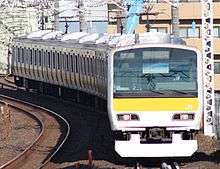
In October 2014, former Yamanote Line set 520 was released from overhaul as a ten-car set, numbered A520, allocated to Mitaka Depot, and finished in the yellow Chuo-Sobu Line livery.[11] It entered revenue service on the Chuo-Sobu Line from 1 December 2014.[12] A second set, former Yamanote Line set 540 was converted to a ten-car set for use on the Chuo-Sobu Line in May 2016, renumbered A540.[13] More sets are being transferred to the Chuo-Sobu Line as the E235 series continues to replace them on the Yamanote Line.[14]
Lines served
- Yamanote Line
- Chuo-Sobu Line
Formations
10-car Chuo-Sobu Line sets
As of 1 July 2018, 20 ten-car sets are based at Mitaka depot in Tokyo and formed as shown below with six motored ("M") cars and four non-powered trailer ("T") cars.[6]
← Chiba, Tsudanuma Mitaka → | ||||||||||
| Car No. | 1 | 2 | 3 | 4 | 5 | 6 | 7 | 8 | 9 | 10 |
|---|---|---|---|---|---|---|---|---|---|---|
| Designation | Tc | M | M' | T | M | M' | T | M | M' | Tc' |
| Numbering | KuHa E231-500 | MoHa E231-500 | MoHa E230-500 | SaHa E231-600 | MoHa E231-500 | MoHa E230-500 | SaHa E231-500 | MoHa E231-500 | MoHa E230-500 | KuHa E230-500 |
11-car Yamanote Line sets
As of 1 July 2018, 32 11-car sets are based at Tokyo General Rolling Stock Centre and formed as shown below with six motored ("M") cars and five non-powered trailer ("T") cars.[14][2]
← Clockwise (Outer) Anticlockwise (Inner) → | |||||||||||
| Car No. | 1 | 2 | 3 | 4 | 5 | 6 | 7 | 8 | 9 | 10 | 11 |
|---|---|---|---|---|---|---|---|---|---|---|---|
| Designation | Tc' | M' | M | T | M' | M | T | M' | M | T | Tc |
| Numbering | KuHa E230-500 | MoHa E230-500 | MoHa E231-500 | SaHa E231-500 | MoHa E230-500 | MoHa E231-500 | SaHa E231-600 | MoHa E230-500 | MoHa E231-500 | SaHa E231-4600 | KuHa E231-500 |
- Cars 3, 6, and 9 each have one PS33B single-arm pantograph.[2]
- Cars 1 and 11 have a wheelchair space.[2]
- Car 4 is designated as a mildly air-conditioned car.[2]
- SaHa E230-500 6-door car as car No. 10 in June 2010
- Replacement SaHa E231-4600 4-door car as car No. 10 in June 2010
 Replacement SaHa E231-600 4-door car as car No. 7 in March 2010
Replacement SaHa E231-600 4-door car as car No. 7 in March 2010
Interior
- Interior view of SaHa E231-500 car
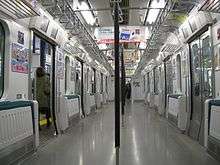 Interior view of SaHa E230-500 car with seats folded up for the rush hour
Interior view of SaHa E230-500 car with seats folded up for the rush hour Interior view of SaHa E231-4600 car, showing E233 series derived interior, April 2010
Interior view of SaHa E231-4600 car, showing E233 series derived interior, April 2010- Passenger information screen
Special liveries
From 7 September to 4 December 2009, E231-500 series set 502 carried an all-over brown livery to mark the 100th anniversary of the naming of Yamanote Line in collaboration with the Meiji Seika confectionery company.
From 16 January to 28 December 2013, Yamanote Line E231-500 series set 545 operated in an all-over uguisu light green livery to mark the 50th anniversary of the first appearance of 103 series EMUs in this colour scheme.[15]
From 11 October 2014 to 31 March 2015, Yamanote Line E231-500 series set 514 operated in an all-over "red brick" livery to commemorate the 100th anniversary of the opening of Tokyo Station, which opened in 1914.[16]
 Set 502 in all-over brown livery in October 2009
Set 502 in all-over brown livery in October 2009 Set 545 in all-over light green livery in January 2013
Set 545 in all-over light green livery in January 2013 Set 514 in "red brick" livery in October 2014
Set 514 in "red brick" livery in October 2014
E231-800 series
| E231-800 series | |
|---|---|
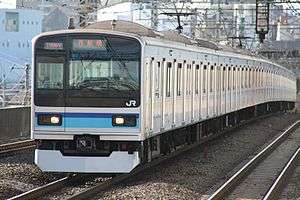 A Chuo-Sobu/Tozai Line 10-car set in December 2009 | |
| Replaced | 103-1200 series, 301 series |
| Constructed | 2003 |
| Entered service | 1 May 2003 |
| Number built | 70 vehicles |
| Number in service | 70 vehicles (7 sets) |
| Formation | 10 cars per trainset |
| Operator(s) | JR East |
| Depot(s) | Mitaka |
| Line(s) served | Chuo-Sobu Line, Tokyo Metro Tozai Line |
| Specifications | |
| Car body construction | Stainless steel |
| Doors | 4 pairs per side |
| Electric system(s) | 1,500 V DC overhead catenary |
| Current collection method | PS33B pantograph |
| Track gauge | 1,067 mm (3 ft 6 in) |
Seven ten-car sets (K1 to K7) based at Mitaka Depot for use on Chuo-Sobu Line and Tokyo Metro Tozai Line interrunning services. These sets were delivered between January and May 2003, entering service on 1 May 2003.[3][17]
Lines served
- Tokyo Metro Tozai Line
- Chuo-Sobu Line (Mitaka - Nakano; Nishi-Funabashi - Tsudanuma)
Formations
As of 1 April 2018, seven ten-car sets (K1 to K7) are based at Mitaka depot in Tokyo and formed as shown below with six motored ("M") cars and four non-powered trailer ("T") cars.[2]
← Tsudanuma, Nishi-Funabashi Nakano, Mitaka → | ||||||||||
| Car No. | 1 | 2 | 3 | 4 | 5 | 6 | 7 | 8 | 9 | 10 |
|---|---|---|---|---|---|---|---|---|---|---|
| Designation | Tc | M | M' | T | M | M' | T | M | M' | Tc' |
| Numbering | KuHa E231-800 | MoHa E231-800 | MoHa E230-800 | SaHa E231-800 | MoHa E231-800 | MoHa E230-800 | SaHa E231-800 | MoHa E231-800 | MoHa E230-800 | KuHa E230-800 |
E231-900 series
| E231-900 series | |
|---|---|
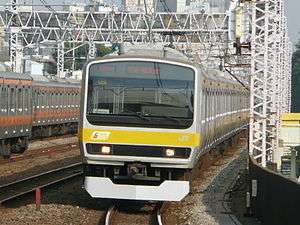 E231-900 series on Chuo-Sobu Line in October 2007 | |
| Constructed | 1998 (as 209-950 series) |
| Entered service | December 1998 |
| Refurbishment | June 2000 |
| Number built | 10 vehicles |
| Number in service | 10 vehicles (1 set) |
| Formation | 10 cars per trainset |
| Operator(s) | JR East |
| Depot(s) | Mitaka |
| Line(s) served | Chuo-Sobu Line |
| Specifications | |
| Car body construction | Stainless steel |
| Width | 2,950 mm (9 ft 8 in) |
| Doors | 4/6 pairs per side |
| Electric system(s) | 1,500 V DC overhead catenary |
| Current collection method | PS33B pantograph |
| Track gauge | 1,067 mm (3 ft 6 in) |
One ten-car set based at Mitaka Depot for use on Chuo-Sobu Line services. This was the prototype E231 series set, built jointly by Tokyu Car and JR East's Niitsu factory, and delivered in October 1998, classified as 209-950 series. It was reclassified as E231-900 series in June 2000.[2]
Formations
As of 1 April 2018, one ten-car set (B901) is based at Mitaka depot in Tokyo and formed as shown below with four motored ("M") cars and six non-powered trailer ("T") cars.[2]
← Chiba, Tsudanuma Mitaka → | ||||||||||
| Car No. | 1 | 2 | 3 | 4 | 5 | 6 | 7 | 8 | 9 | 10 |
|---|---|---|---|---|---|---|---|---|---|---|
| Designation | Tc | T | M | M' | T' | T | T | M | M' | Tc' |
| Numbering | KuHa E231-900 | SaHa E231-900 | MoHa E231-900 | MoHa E230-900 | SaHa E230-900 | SaHa E231-900 | SaHa E231-900 | MoHa E231-900 | MoHa E230-900 | KuHa E230-900 |
E231-1000 series
| E231-1000 series | |
|---|---|
 A E231-1000 series suburban set on a Takasaki Line service in December 2008 | |
| Replaced | 111 series, 113 series, 115 series |
| Constructed | 2000–2006 |
| Entered service | 21 June 2000 |
| Number built | 1255 vehicles |
| Number in service | 1255 vehicles (160 sets) |
| Formation | 5/10 cars per trainset |
| Operator(s) | JR East |
| Depot(s) | Kōzu, Oyama |
| Line(s) served | Ito Line, Joetsu Line, Ryōmō Line, Shonan-Shinjuku Line, Takasaki Line, Tokaido Main Line, Utsunomiya Line, Yokosuka Line |
| Specifications | |
| Car body construction | Stainless steel |
| Width | 2,950 mm (9 ft 8 in) |
| Doors |
4 pairs per side 2 doors per side (Green cars) |
| Electric system(s) | 1,500 V DC overhead catenary |
| Current collection method | PS33B pantograph |
| Track gauge | 1,067 mm (3 ft 6 in) |
Lines served

Ten- and five-car suburban sets based at Oyama and Kōzu depots for use on the following lines.
- Takasaki Line (Ueno - Takasaki) and Joetsu Line (Takasaki - Shin-Maebashi) and Ryōmō Line (Shin-Maebashi - Maebashi)
- Utsunomiya Line (Ueno - Kuroiso)
- Tokaido Main Line (Tokyo - Atami / Numazu)
- Itō Line (Atami - Itō, through services from Tokaido Main Line)
- Ueno-Tokyo Line (Ueno - Tokyo)
- Takasaki Line (Ueno - Takasaki), Joetsu Line (Takasaki - Shin-Maebashi) and Ryōmō Line (Shin-Maebashi - Maebashi)
- Utsunomiya Line (Ueno - Kuroiso)
- Tokaido Main Line (Tokyo - Atami / Numazu) and Itō Line (Atami to Itō)
- Shonan-Shinjuku Line (Ōfuna - Ōmiya )
- Yokosuka Line (Zushi - Ōfuna) and Utsunomiya Line (Ōmiya - Utsunomiya)
- Tokaido Main Line (Ōfuna - Odawara), Takasaki Line (Ōmiya - Takasaki), Joetsu Line (Takasaki - Shin-Maebashi) and Ryōmō Line (Shin-Maebashi - Maebashi)
These trains are designed for longer-distance suburban services, and include toilets, transverse seating bays (in some cars only), and bilevel Green cars (10-car sets only). The Ito Line and Joetsu Line mainly use 5-car sets, while the Shonan-Shinjuku Line, Ueno-Tokyo Line, Takasaki Line, Tokaido Line, Utsunomiya Line use 10- or 10+5-car sets.
Formations
10-car U sets
As of 1 April 2018, 49 ten-car sets (U501–U541, U584–U591) are based at Oyama depot in Tochigi Prefecture and formed as shown below with four motored ("M") cars and six non-powered trailer ("T") cars.[2]
← Atami Kuroiso, Maebashi → | ||||||||||
| Car No. | 1 | 2 | 3 | 4 | 5 | 6 | 7 | 8 | 9 | 10 |
|---|---|---|---|---|---|---|---|---|---|---|
| Designation | Tc' | M' | M | Tsd' | Tsd | T | M' | M | T | Tc |
| Numbering | KuHa E230-8000 | MoHa E230-3500 | MoHa E231-1500 | SaRo E230-1000 | SaRo E231-1000 | SaHa E231-6000 | MoHa E230-1000 | MoHa E231-1000 | SaHa E231-1000 | KuHa E231-6000 |
- Cars 3 and 8 each have one PS33B single-arm pantograph.[2]
- Cars 1 and 10 have a wheelchair space.[2]
- Cars 1, 5, and 6 each have a toilet (universal design in car 1, Japanese-style in car 6).[2]
- Car 8 is designated as a mildly air-conditioned car.[2]
- Cars 4 and 5 are bilevel Green Cars.[2]
5-car U sets
As of 1 April 2018, 35 five-car sets (U2–U118) are based at Oyama depot in Tochigi Prefecture and formed as shown below with two motored ("M") cars and three non-powered trailer ("T") cars.[2]
← Atami Koganei, Kagohara → | |||||
| Car No. | 11 | 12 | 13 | 14 | 15 |
|---|---|---|---|---|---|
| Designation | Tc' | M' | M | T | Tc |
| Numbering | KuHa E230-6000 | MoHa E230-1000 | MoHa E231-1000 | SaHa E231-3000 | KuHa E231-8000 |
- Car 13 has one PS33B single-arm pantograph.[2]
- Cars 11 and 15 have a wheelchair space.[2]
- Car 11 has a universal design toilet.[2]
10-car K sets
As of 1 April 2018, 42 ten-car sets (K-01–K-42) are based at Kōzu depot in Kanagawa Prefecture and formed as shown below with four motored ("M") cars and six non-powered trailer ("T") cars.[2]
← Atami Kuroiso, Maebashi → | ||||||||||
| Car No. | 1 | 2 | 3 | 4 | 5 | 6 | 7 | 8 | 9 | 10 |
|---|---|---|---|---|---|---|---|---|---|---|
| Designation | Tc' | M' | M | Tsd' | Tsd | T | T | M' | M | Tc |
| Numbering | KuHa E230-8000 | MoHa E230-3500 | MoHa E231-1500 | SaRo E230-1000 | SaRo E231-1000 | SaHa E231-1000 | SaHa E231-1000 | MoHa E230-1500 | MoHa E231-3500 | KuHa E231-8500 |
5-car S sets
As of 1 April 2018, 34 five-car sets (S-01–S-34) are based at Kōzu depot in Kanagawa Prefecture and formed as shown below with two motored ("M") cars and three non-powered trailer ("T") cars.[2]
← Atami Koganei, Kagohara → | |||||
| Car No. | 11 | 12 | 13 | 14 | 15 |
|---|---|---|---|---|---|
| Designation | Tc' | M' | M | T | Tc |
| Numbering | KuHa E230-6000 | MoHa E230-1000 | MoHa E231-1000 | SaHa E231-3000 | KuHa E231-8000 |
- Car 13 has one PS33B single-arm pantograph.[2]
- Cars 11 and 15 have a wheelchair space.[2]
- Car 11 has a universal design toilet.[2]
Interior
 Interior of car with longitudinal seating
Interior of car with longitudinal seating Interior of car with transverse seating bays
Interior of car with transverse seating bays- Toilet
- Driver's cab end
- Bilevel Green Car lower deck with 2+2 seating
- Bilevel Green Car upper deck with 2+2 seating
E231-3000 series
| E231-3000 series | |
|---|---|
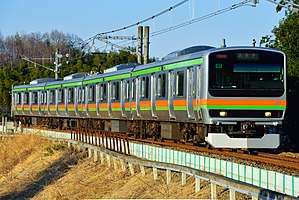 A Hachiko/Kawagoe Line four-car set in March 2018 | |
| Replaced | 205-3000 series, 209-3000 series, 209-3100 series |
| Entered service | 19 February 2018 |
| Refurbishment | 2018–present (converted from E231-0 series) |
| Number built | 8 vehicles |
| Number in service | 8 vehicles (2 sets) |
| Formation | 4 cars per trainset |
| Operator(s) | JR East |
| Depot(s) | Kawagoe |
| Line(s) served | Hachiko Line, Kawagoe Line |
| Specifications | |
| Car body construction | Stainless steel |
| Width | 2,950 mm (9 ft 8 in) |
| Doors | 4 pairs per side |
| Electric system(s) | 1,500 V DC overhead catenary |
| Current collection method | PS33B pantograph |
| Track gauge | 1,067 mm (3 ft 6 in) |
From 2017, former E231-0 series ten-car sets based at Mitaka Depot for use on Chuo-Sobu Line services were reformed and converted to become four-car E231-3000 series sets based at Kawagoe for use on Kawagoe Line and Hachiko Line services.[18] The first set entered revenue service on the line on 19 February 2018.[19]
Lines served
- Hachiko Line (Hachioji - Komagawa)
- Kawagoe Line (Komagawa - Kawagoe)
Formation
As of 1 April 2018, two four-car sets are based at Kawagoe depot in Saitama and formed as shown below with two motored ("M") cars and two non-powered trailer ("T") cars.[2]
← Hachioji Kawagoe → | ||||
| Car No. | 1 | 2 | 3 | 4 |
|---|---|---|---|---|
| Designation | Tc' | M' | M | Tc |
| Numbering | KuHa E230-3000 | MoHa E230-3000 | MoHa E231-3000 | KuHa E231-3000 |
Former set/car identities
The former identities of the E231-3000 series sets are as follows.[20]
| Set No. | Car numbers | Former set No. | Former car numbers | ||||||
|---|---|---|---|---|---|---|---|---|---|
| 41 | KuHa E230-3001 | MoHa E230-3001 | MoHa E231-3001 | KuHa E231-3001 | B5 | KuHa E230-5 | MoHa E230-10 | MoHa E231-10 | KuHa E231-5 |
| 42 | KuHa E230-3002 | MoHa E230-3002 | MoHa E231-3002 | KuHa E231-3002 | B6 | KuHa E230-6 | MoHa E230-12 | MoHa E231-12 | KuHa E231-6 |
See also
- E233 series, successor
- E331 series, experimental articulated train
- E531 series, dual-voltage derivative
- Sotetsu 10000 series, an E231 series derivative
- Toei 10-300 series, an E231 series derivative
- Tokyu 5000 series, an E231 series derivative
- KCR EMU SP1900, based on E231 series technology
- Nankai 8000 series, partly using same parts as E231
References
- 1 2 3 Jēāru zensharyō handobukku: Rail Magazine 2009 JR全車輌ハンドブック2009 [JR Rolling Stock Handbook 2009]. Japan: Neko Publishing. 2009. ISBN 978-4-7770-0836-0.
- 1 2 3 4 5 6 7 8 9 10 11 12 13 14 15 16 17 18 19 20 21 22 23 24 25 26 27 28 29 30 31 32 33 34 35 36 37 38 39 40 41 42 43 44 45 46 47 48 49 50 51 52 53 54 55 56 57 Jr電車編成表 2018夏 JR電車編成表 2018夏 [JR EMU Formations - Summer 2018]. Japan: Kotsu Shimbunsha. 18 May 2018. pp. 49, 62–63, 71, 74–77, 80–81, 96–98. ISBN 978-4-330-88418-9.
- 1 2 3 JR電車編成表 2009夏 [JR EMU Formations - Summer 2009]. Japan: Kotsu Shimbunsha. June 2009. ISBN 978-4-330-06909-8.
- ↑ 武蔵野線にE231系が登場 [E231 series appears on the Musashino Line]. Japan Railfan Magazine (in Japanese). Vol. 58 no. 681. Japan: Koyusha Co., Ltd. January 2018. p. 52.
- ↑ "中央総武緩行線からの転出". Retrieved 21 July 2018.
- 1 2 3 "E231系三鷹車両センター編成表(最新版)". Retrieved 21 July 2018.
- ↑ "E231系京葉車両センター編成表(最新版)". Retrieved 21 July 2018.
- 1 2 "山手線6扉車を順次4扉車に (Yamanote Line 6-door cars to be gradually replaced with 4-door cars)". Hobidas (in Japanese). Neko Publishing. 17 February 2010. Retrieved 17 February 2010.
- ↑ "山手線電車100周年" [100th anniversary of Yamanote Line trains]. Japan Railfan Magazine. Vol. 50 no. 586. Japan: Koyusha. February 2010. p. 57.
- ↑ 山手線用E231系4ドア車配給輸送 [Yamanote Line E231 series 4-door cars delivered] (in Japanese). 1 February 2010. Retrieved 1 February 2010.
- ↑ E231系500番台が中央・総武緩行線仕様となって出場 [E231-500 series outshopped in Chuo-Sobu Line style]. Japan Railfan Magazine Online (in Japanese). Japan: Koyusha Co., Ltd. 29 October 2014. Retrieved 30 November 2014.
- ↑ 中央総武緩行線でE231系500番台が営業運転を開始 [E231-500 series enters revenue service on Chuo-Sobu Line]. Japan Railfan Magazine Online (in Japanese). Japan: Koyusha Co., Ltd. 2 December 2014. Retrieved 2 December 2014.
- ↑ E231系トウ540編成が三鷹車両センターに転属 [E231 series set 540 transferred to Mitaka Depot]. Japan Railfan Magazine Online (in Japanese). Japan: Koyusha Co., Ltd. 20 May 2016. Archived from the original on 11 June 2016. Retrieved 11 June 2016.
- 1 2 "「山手線・中央総武緩行線の世代交代」について". Retrieved 21 July 2018.
- ↑ 「みどりの山手線ラッピングトレイン」を運行します ["Green Yamanote Line Train" to operate] (pdf). News release (in Japanese). Japan: East Japan Railway Company. 19 December 2012. Retrieved 19 December 2012.
- ↑ "E231系トウ514編成に東京駅開業100周年記念のラッピング" [E231 series set 514 in Tokyo Station 100th anniversary commemorative livery]. Japan Railfan Magazine Online (in Japanese). Japan: Koyusha Co., Ltd. 12 October 2014. Retrieved 13 October 2014.
- ↑ "JR東日本 E231系800番代 5月1日に営業運転を開始" [JR East E231-800 series enters revenue service on 1 May]. Tetsudō Daiya Jōhō. 32 (231): 72. July 2003.
- ↑ E231系3000番台4両が配給輸送される [E231-3000 series 4-car set transferred]. Japan Railfan Magazine Online (in Japanese). Japan: Koyusha Co., Ltd. 29 November 2017. Archived from the original on 29 November 2017. Retrieved 29 November 2017.
- ↑ 八高線用の209系3500番台が試運転 [Hachiko Line 209-3500 series undergoes test-running]. Japan Railfan Magazine Online (in Japanese). Japan: Koyusha Co., Ltd. 21 February 2018. Archived from the original on 21 February 2018. Retrieved 21 February 2018.
- ↑ JR車両のうごき [JR rolling stock changes]. Tetsudo Daiya Joho Magazine (in Japanese). Vol. 47 no. 407. Japan: Kotsu Shimbun. March 2018. p. 102.
Further reading
- 首都圏新系列車両 Profile: 209/E231/E233系グループの全貌 首都圏新系列車両PROFILE [Tokyo Area New-generation Rolling Stock Profile]. Japan: Ikaros Publishing. 15 April 2011. ISBN 978-4-86320-436-2.
External links
| Wikimedia Commons has media related to E231 series. |
- JR E231 series (in Japanese)
- Kawasaki Heavy Industries product information (in Japanese)
- Tokyu Car product information (in Japanese)